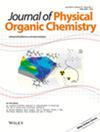Exploring Spectral and Electrochemical Behavior of Hydroxy-N-Benzylideneanilines by Integrated Theoretical and Experimental Approaches
Abstract
The present work explored the effect of –OH group substitution (o/p) on the spectral and electrochemical behavior of N-benzylideneaniline. The geometry optimization of unsubstituted and (o/p)-OH-substituted analogs revealed the coplanarity of the molecules. The vibrational spectra of the compounds were computed using density functional theory (DFT) and compared with the experimental data. The observed bands were assigned based on total energy distribution (TED). Predicted electronic absorption spectra from time-dependent density functional theory (TD-DFT) calculation were compared with the UV–visible spectra of the molecules. The analysis of the lowest spin-allowed (singlet-singlet) excited states divulged possible electronic transition. The o-substituted benzylideneaniline possessed the lowest highest occupied molecular orbital (HOMO)–lowest unoccupied molecular orbital (LUMO) energy gap among the substituted and unsubstituted analogs. The intramolecular contacts were interpreted using natural bond orbital and localized molecular orbital analysis. The –CH=N– linkage was investigated as a bridge for the electron delocalization from the donor to acceptor moieties. The manifestation of a reduction peak in the cyclic voltammetric studies confirmed the electrochemical behavior in the –OH-substituted molecule, which was diffusion-controlled. The discrepancy in the electrochemical property concerning the position of the –OH substituent of the candidate molecules was put forward.

 求助内容:
求助内容: 应助结果提醒方式:
应助结果提醒方式:


